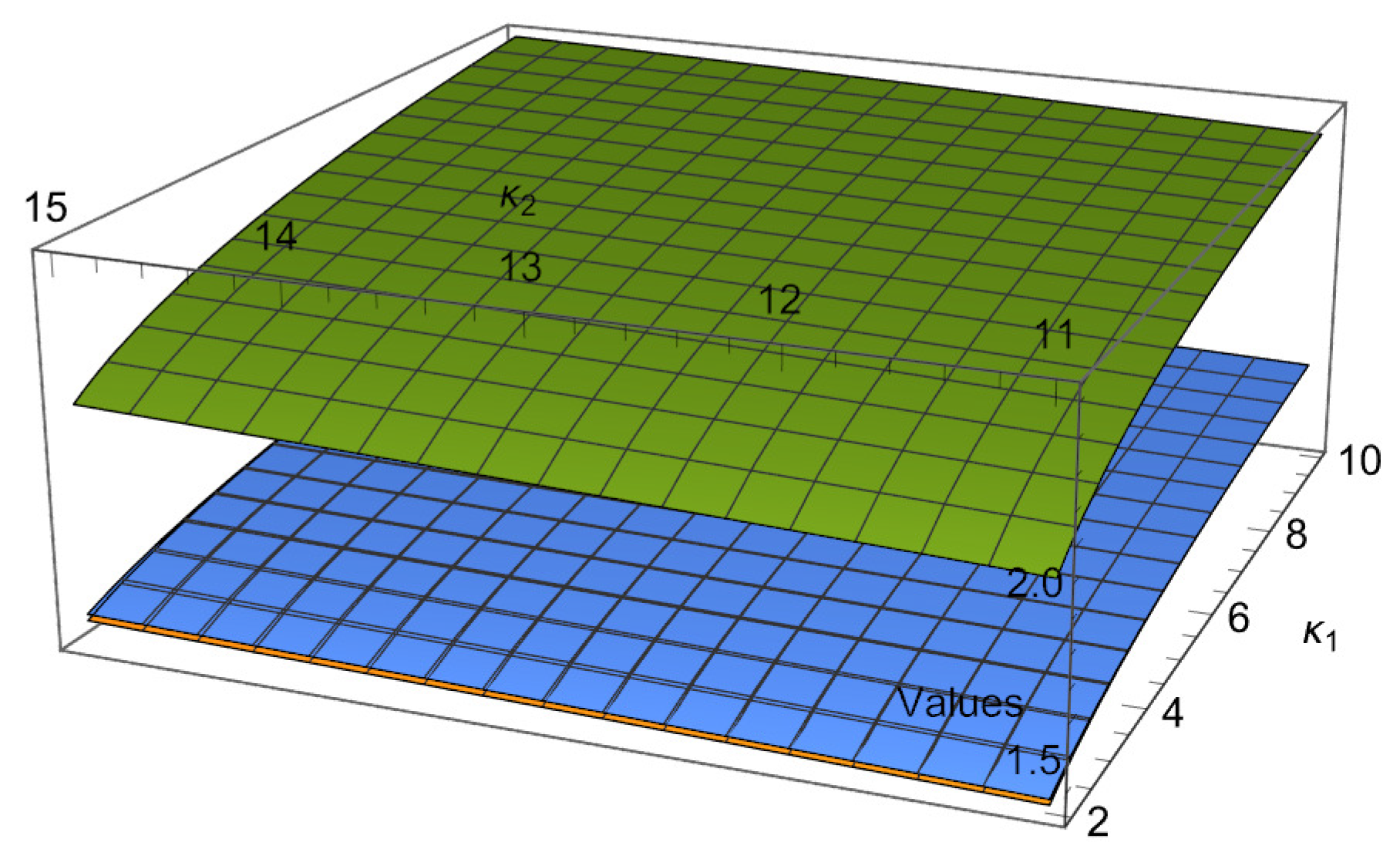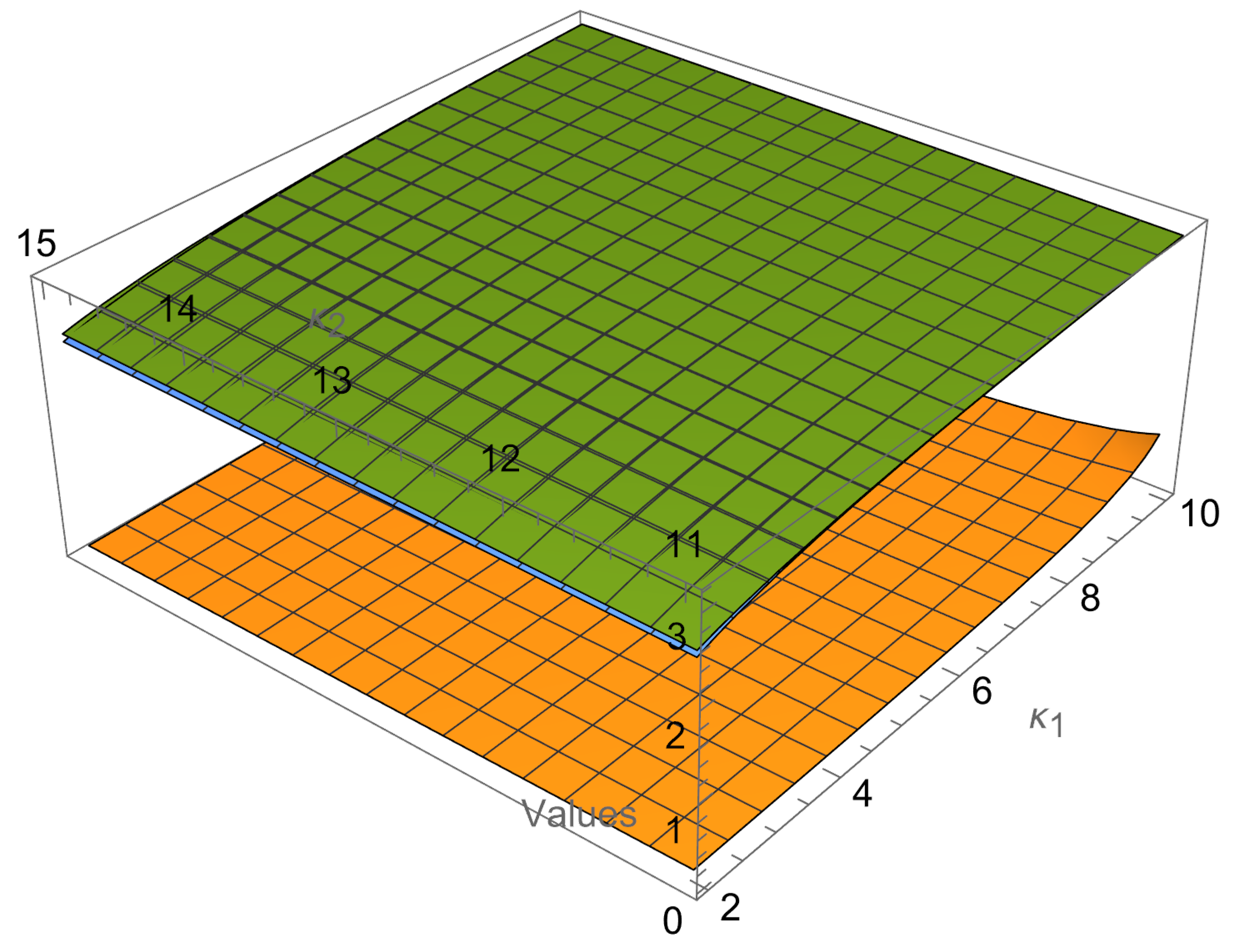Properties of GA-h-Convex Functions in Connection to the Hermite–Hadamard–Fejér-Type Inequalities
Abstract
:1. Introduction
2. The Hermite–Hadamard–Fejér Inequalities for a --Convex Function
- (i)
- The function φ is convex, that is, if , then
- (ii)
- The function φ is s-convex, that is, if , , then
- (i)
- If h is multiplicative or
- (ii)
- If h is supermultiplicative and φ is non-negativeand if φ is a -h-convex function, then inequality (15) holds for
- (a)
- If φ is -convex, i.e., , then inequality (15) holds for .Furthermore, if , for and if h is multiplicative or if h is supermultiplicative and φ is non-negative, then inequality (15) holds for
- (b)
- If φ is -s-convex, i.e., , then inequality (15) holds for .Furthermore, if , for and if h is multiplicative or if h is supermultiplicative and φ is non-negative, then inequality (15) holds for
3. Mappings Connected with the Hermite–Hadamard-Type Inequalities for -Convex Functions
4. Applications to Special Means
- (i)
- The function is -convex if
- (a)
- and ;
- (b)
- and .
- (ii)
- The function is -concave if
- (a)
- and ;
- (b)
- and .
- (i)
- The function is --convex if
- (a)
- and ;
- (b)
- and .
- (ii)
- The function is --concave if
- (a)
- and ;
- (b)
- and .
5. Conclusions
Funding
Data Availability Statement
Acknowledgments
Conflicts of Interest
References
- Hermite, C. Sur deux limites d’une intégrale dé finie. Mathesis 1893, 3, 82. [Google Scholar]
- Hadamard, J. Étude sur les propriétés des fonctions entiéres en particulier d’une function considéré par Riemann. J. Math. Pures Appl. 1893, 58, 171–215. [Google Scholar]
- Hwang, D.-Y.; Tseng, K.-L.; Yang, G.S. Some Hadamard’s Inequalities for Coordinated Convex Functions in a Rectangle from the Plane. Taiwan. J. Math. 2007, 11, 63–73. [Google Scholar] [CrossRef]
- Ardic, M.A.; Akdemir, A.O.; Set, E. New Ostrowski like inequalities for GG-convex and GA-convex functions. Math. Ineq. Appl. 2016, 19, 1159–1168. [Google Scholar]
- Ardic, M.A.; Akdemir, A.O.; Yildiz, K. On some new inequalities via GG-convexity and GA-convexity. Filomat 2018, 32, 5707–5717. [Google Scholar] [CrossRef] [Green Version]
- Dragomir, S.S.; Pearce, C.E.M. Selected topics on Hermite Hadamard inequalities and applications. In RGMIA Monographs; Victoria University: Victoria, Australia, 2000; Available online: http://www.staff.vu.edu.au/RGMIA/monographs/hermite_hadamard.html (accessed on 1 January 2020).
- Dragomir, S.S.; Agarwal, R.P. Two inequalities for differentiable mappings and applications to special means of real numbers and to Trapezoidal formula. Appl. Math. Lett. 1998, 11, 91–95. [Google Scholar] [CrossRef] [Green Version]
- Dragomir, S.S. Two mappings in connection to Hadamardís inequalities. J. Math. Anal. Appl. 1992, 167, 49–56. [Google Scholar] [CrossRef] [Green Version]
- Dragomir, S.S.; Latif, M.A.; Momoniat, E. Fejér type integral inequalities related with geometrically-arithmetically convex functions with applications. Acta Comment. Univ. Tartu. Math. 2019, 23, 51–64. [Google Scholar] [CrossRef] [Green Version]
- Dragomir, S.S. Iequalities of Hermite-Hadamard type for GA-convex functions. Ann. Math. Sil. 2018, 32, 145–168. [Google Scholar]
- Dragomir, S.S. Inequalities of Jensen type for GA-convex functions. RGMIA Res. Rep. Collect. 2015, 18, 1–26. [Google Scholar]
- Dragomir, S.S.; Cho, Y.J.; Kim, S.S. Inequalities of Hadamard’s type for Lipschitzian mappings and their applications. J. Math. Anal. Appl. 2000, 245, 489–501. [Google Scholar] [CrossRef] [Green Version]
- Dragomir, S.S.; Milosevic, D.S.; Sandor, J. On some refinements of Hadamard’s inequalities and applications. Univ. Belgrad. Publ. Elek. Fak. Sci. Math. 1993, 4, 3–10. [Google Scholar]
- Dragomir, S.S. On Hadamard’s inequality for convex functions. Mat. Balk. 1992, 6, 215–222. [Google Scholar] [CrossRef] [Green Version]
- Dragomir, S.S. On Hadamard’s inequality for the convex mappings defined on a ball in the space and applications. Math. Ineq. Appl. 2000, 3, 177–187. [Google Scholar] [CrossRef] [Green Version]
- Dragomir, S.S. On some integral inequalities for convex functions. Zb.-Rad. 1996, 18, 21–25. [Google Scholar]
- Dragomir, S.S.; Agarwal, R.P. Two new mappings associated with Hadamard’s inequalities for convex functions. Appl. Math. Lett. 1998, 11, 33–38. [Google Scholar] [CrossRef]
- Kunt, M.; İşcan, İ. Fractional Hermite-Hadamard-Fejér type inequalitıes for GA-convex functions. Turk. J. Ineq. 2018, 2, 1–20. [Google Scholar]
- İşcan, İ. Hermite-Hadamard type inequalities for GA-s-convex functions. Matematiche 2014, 19, 129–146. [Google Scholar]
- Latif, M.A. New Hermite-Hadamard type integral inequalities for GA-convex functions with applications. Analysis 2014, 34, 379–389. [Google Scholar] [CrossRef]
- Latif, M.A.; Dragomir, S.S.; Momoniat, E. Some estimates on the Hermite-Hadamard inequality through geometrically quasi-convex functions. Miskolc Math. Notes 2017, 18, 933–946. [Google Scholar] [CrossRef]
- Latif, M.A. Hermite-Hadamard type inequalities for GA-convex functions on the co-ordinates with applications. Proc. Pak. Acad. Sci. 2015, 52, 367–379. [Google Scholar]
- Latif, M.A. Weighted Hermite-Hadamard type inequalities for differentiable GA-convex and geometrically quasi-convex mappings. Rocky Mt. J. Math. 2022, 51, 1899–1908. [Google Scholar]
- Latif, M.A. Some companions of Fejér type inequalities using GA-convex functions. Mathematics 2023, 11, 392. [Google Scholar] [CrossRef]
- Niculescu, C.P. Convexity according to the geometric mean. Math. Inequal. Appl. 2000, 3, 155–167. [Google Scholar] [CrossRef] [Green Version]
- Obeidat, S.; Latif, M.A. Weighted version of Hermite-Hadamard type inequalities for geometrically quasi-convex functions and their applications. J. Inequal. Appl. 2018, 2018, 307. [Google Scholar] [CrossRef] [Green Version]
- Qi, F.; Xi, B.-Y. Some Hermite-Hadamard type inequalities for geometrically quasi-convex functions. Proc. Indian Acad. Sci. Math. Sci. 2014, 124, 333–342. [Google Scholar] [CrossRef]
- Tseng, K.-L.; Hwang, S.R.; Dragomir, S.S. On some new inequalities of Hermite-Hadamard- Fejér type involving convex functions. Demonstr. Math. 2007, XL, 51–64. [Google Scholar] [CrossRef] [Green Version]
- Tseng, K.-L.; Hwang, S.R.; Dragomir, S.S. Fejér-Type Inequalities (I). J. Inequal. Appl. 2010, 2010, 531976. [Google Scholar] [CrossRef] [Green Version]
- Tseng, K.-L.; Hwang, S.R.; Dragomir, S.S. Some companions of Fejér’s inequality for convex functions. Racsam 2015, 109, 645–656. [Google Scholar] [CrossRef] [Green Version]
- Tseng, K.-L.; Hwang, S.R.; Dragomir, S.S. Fejér-type Inequalities (II). Math. Slovaca 2017, 67, 109–120. [Google Scholar] [CrossRef]
- Tseng, K.-L.; Hwang, S.R.; Dragomir, S.S. On some weighted integral inequalities for convex functions related Fejér result. Filomat 2011, 25, 195–218. [Google Scholar] [CrossRef]
- Tseng, K.-L.; Yang, G.-S.; Hsu, K.-C. On some inequalities for Hadamard’s type and applications. Taiwan. J. Math. 2009, 13, 1929–1948. [Google Scholar] [CrossRef]
- Xiang, R. Refinements of Hermite-Hadamard type inequalities for convex functions via fractional integrals. J. Appl. Math. Inform. 2015, 33, 119–125. [Google Scholar] [CrossRef] [Green Version]
- Yang, G.S.; Hong, M.C. A note on Hadamard’s inequality. Tamkang. J. Math. 1997, 28, 33–37. [Google Scholar] [CrossRef]
- Yang, G.S.; Tseng, K.L. On certain integral inequalities related to Hermite-Hadamard inequalities. J. Math. Anal. Appl. 1999, 239, 180–187. [Google Scholar] [CrossRef] [Green Version]
- Yang, G.S.; Tseng, K.L. Inequalities of Hadamard’s type for Lipschitzian mappings. J. Math. Anal. Appl. 2001, 260, 230–238. [Google Scholar] [CrossRef] [Green Version]
- Yang, G.S.; Tseng, K.L. On certain multiple integral inequalities related to Hermite-Hadamard inequalities. Util. Math. 2002, 62, 131–142. [Google Scholar]
- Yang, G.S.; Tseng, K.L. Inequalities of Hermite-Hadamard-Fejér type for convex functions and Lipschitzian functions. Taiwan. J. Math. 2003, 7, 433–440. [Google Scholar]
- Zhang, X.-M.; Chu, Y.-M.; Zhang, X.-H. The Hermite-Hadamard type inequality of GA-convex functions and its application. J. Inequal. Appl. 2010, 2010, 507560. [Google Scholar] [CrossRef] [Green Version]
- Hudzik, H.; Maligranda, L. Some remarks on s-convex functions. Aequ. Math. 1994, 48, 100–111. [Google Scholar] [CrossRef]
- Dragomir, S.S.; Fitzpatrick, S. The Hadamard’s inequality for s-convex functions in the second sense. Demonstr. Math. 1999, 32, 687–696. [Google Scholar]
- Varošanec, S. On h-convexity. J. Math. Anal. Appl. 2007, 326, 303–311. [Google Scholar] [CrossRef] [Green Version]
- Fejér, L. Über die Fourierreihen, II, Math. Naturwiss. Anz Ungar. Akad. Wiss. 1906, 24, 369–390. (In Hungarian) [Google Scholar]
- Bombardelli, M.; Varošanec, S. Properties of h-convex functions related to the Hermite-Hadamard-Fejér inequalities. Comput. Math. Appl. 2009, 58, 1869–1877. [Google Scholar] [CrossRef] [Green Version]
- Dragomir, S.S. Some new inequalities of Hermite-Hadamard type for GA-convex functions. Ann. Univ. Mariae-Curie-Sklodowska Lublin-Pol. 2018, LXXII, 55–68. [Google Scholar] [CrossRef]
- MNoor, M.A.; Noor, K.I.; Awan, M.U. Some inequalities for geometrically-arithmetically h-convex functions. Creat. Math. Inform. 2014, 23, 91–98. [Google Scholar]
- Latif, M.A.; Dragomir, S.S.; Momoniat, E. Some Fejér type integral inequalities for geometrically-arithmetically-convex functions with applications. Filomat 2018, 32, 2193–2206. [Google Scholar] [CrossRef] [Green Version]
- Latif, M.A.; Kalsoom, H.; Khan, Z.A.; Al-Moneef, A.A. Refinement mappings related to Hermite-Hadamard type inequalities for GA-convex sunction. Mathematics 2022, 10, 1398. [Google Scholar] [CrossRef]


Disclaimer/Publisher’s Note: The statements, opinions and data contained in all publications are solely those of the individual author(s) and contributor(s) and not of MDPI and/or the editor(s). MDPI and/or the editor(s) disclaim responsibility for any injury to people or property resulting from any ideas, methods, instructions or products referred to in the content. |
© 2023 by the author. Licensee MDPI, Basel, Switzerland. This article is an open access article distributed under the terms and conditions of the Creative Commons Attribution (CC BY) license (https://creativecommons.org/licenses/by/4.0/).
Share and Cite
Amer Latif, M. Properties of GA-h-Convex Functions in Connection to the Hermite–Hadamard–Fejér-Type Inequalities. Mathematics 2023, 11, 3172. https://doi.org/10.3390/math11143172
Amer Latif M. Properties of GA-h-Convex Functions in Connection to the Hermite–Hadamard–Fejér-Type Inequalities. Mathematics. 2023; 11(14):3172. https://doi.org/10.3390/math11143172
Chicago/Turabian StyleAmer Latif, Muhammad. 2023. "Properties of GA-h-Convex Functions in Connection to the Hermite–Hadamard–Fejér-Type Inequalities" Mathematics 11, no. 14: 3172. https://doi.org/10.3390/math11143172
APA StyleAmer Latif, M. (2023). Properties of GA-h-Convex Functions in Connection to the Hermite–Hadamard–Fejér-Type Inequalities. Mathematics, 11(14), 3172. https://doi.org/10.3390/math11143172





